Search the Special Collections and Archives Portal
Search Results
Bella Tyktin Stern Papers
Identifier
Abstract
The Bella Tyktin Stern papers (approximately 1930-1997) document the life and travels of Las Vegas, Nevada resident Bella Tyktin Stern. The collection focuses on the trips she took within the state of Nevada as a guide for Nevada Discovery Tours, featuring travel itineraries and travel brochures. The collection also includes biographical materials, such as personal correspondence, legal documents, postcards sent to Stern from her Aunt Rose, and an untranslated copy of Stern's unpublished autobiography written in German,
Archival Collection

Domingo Cambeiro oral history interview: transcript
Date
Archival Collection
Description
Oral history interview with Domingo Cambeiro conducted by Stefani Evans and Claytee D. White on October 18, 2016 for the Building Las Vegas Oral History Project. In this interview, Cambeiro discusses his upbringing in Havana, Cuba. He talks about his initial interests in architecture, starting his own architecture drawing service, and attending the University of Havana. Cambeiro recalls submitting a request to leave Cuba, emigrating to the United States, and arriving in Las Vegas, Nevada in 1962. Cambeiro talks about working with Las Vegas architect Julius Gabriel, obtaining his architecture license, and starting an architectural firm. Lastly, Cambeiro discusses being selected to create architectural drawings for the Thomas & Mack Center.
Text
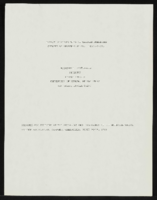
"Impact of Stereotypes of Mexican Americans Created by Selected Films: 1920s-1960s" paper by Roosevelt Fitzgerald
Date
Archival Collection
Description
From the Roosevelt Fitzgerald Professional Papers (MS-01082) -- Unpublished manuscripts file. Presented at the Social Science Conference of the National Social Science Association, Newport Beach, California.
Text
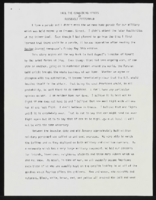
"Hail the Conquering Heroes": article draft by Roosevelt Fitzgerald
Date
Archival Collection
Description
From the Roosevelt Fitzgerald Professional Papers (MS-01082) -- Drafts for the Las Vegas Sentinel Voice file. On returning Black veterans not given same welcome or recognition for military service.
Text

Photograph of the front exterior of the Hotel Nevada (Las Vegas), circa 1910
Date
Archival Collection
Description
Hotel Nevada after the addition of a balcony. Transcribed from photo sleeve: "by Florence Lee Jones ... March, 1969. Early Las Vegas History. The Hotel Nevada, at the Southeast corner of Main and Fremont Streets, is the oldest continuous hotel business in Las Vegas, although it has been known as Sal Sagev (Las Vegas spelled backward) since 1928. The hostelry started as a tent in 1905, but the late John Miller soon erected a permanent building, shown above, which provided the most luxurious accommodations and the best food in Las Vegas for many years. In the 1930's the Sal Sagev Hotel had one of the three elevators in town. A private dining room was a popular place for private parties for the elite of the town. The hotel is now owned and operated by Miller's son, Abe Miller, and his daughter, Mrs. Sherman E. Nugent. The Golden Gate Club now occupies much of the first floor of the building. On the North side of the building is a sign "Bank of Southern Nevada", which was the second bank established in Las Vegas. (The other was the First State Bank.) Started by John F. Miller, Ed Von Tobel, Sr., Will Beckley, Attorney Frank Stevens, and Hal D. Buzick, the Bank of Southern Nevada was an important factor in Southern Nevada's economy. During the 1930's and the Depression, the federal government issued restrictive orders on bank operations. The reaction of the independent Las Vegans was 'No guy in Washington is going to tell us how to run our bank.' ... So they paid off all the depositors and closed the bank. The Rhoads & Rhoads General Machine Works (extreme right) was one of the first automobile agencies in town - the start of Community Chevrolet."
Site Name: Hotel Nevada
Address: 1 Fremont Street
Image
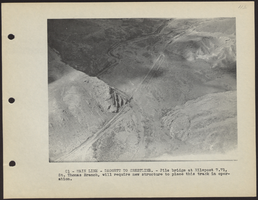
Photographic record of storm damage to Union Pacific Railroad railway lines, March 2, 1938
Date
Archival Collection
Description
Selected pages from a photographic record book of the damage to the main rail line from California to Utah from a 1938 storm. Text accompanying photos include description of track location.
Text

Film strip of individuals or Hoover Dam construction, image 007: photographic print
Date
Archival Collection
Description
Image
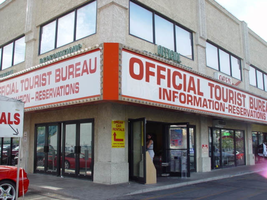
Photographs of Official Tourist Bureau and Viva Vegas Gifts signs, Las Vegas (Nev.), 2002
Date
Archival Collection
Description
Site address: 3734 S Las Vegas Blvd
Sign details: The signage of the property is a wrapping fascia of horizontal message boards, which advertise for the businesses present. The building is a two story complex on the west-side of Las Vegas Blvd, facing east with a small parking lot along the front and on the south sides. The signage is present on the south and east walls. The signage acts as an artificial marker denoting the difference between the row of doors and wall size windows below, and the large panes of glass and tan stucco finish of the upper level.
Sign condition: Structure 4 Surface 3 Lighting 3
Sign form: Fascia
Sign-specific description: The advertisements are broken up into two distinct sections, but are treated aesthetically the same to retain the continuity of the property. The first is a red steel cabinet, which wraps the southeast corner. The faces of the east and south sides are bordered with aluminum, gold polished raceways, lined with incandescent bulbs. The backlit panels possess text which occupies the majority of the white surface. In red text, both of the sides read, "Official tourist bureau," above "Information-reservations." On the east side of the building above the cabinet, two tan horizontal steel boxes, support green channel letters that read in two lines, "Official," then "Tourist Bureau." Above the south face of the signage two separate sections of the green text read "Information" on the left side of the sign, and "Reservations" on the right hand side. They are treated the same as the previous text on the east face, with letters that possess green neon on the interior, and are in all caps. Further north, on the east face of the building, is another cabinet. This sign is only one side, occupying the flat plane of the remainder of the east face of the building. It too is a red steel cabinet with a back-lit face. On the left hand side of the face the two lined text reads "Viva Vegas," a top the word "Gifts." The second line of the text is flanked on either side by red graphic images of diamonds. The right hand portion of the sign reads prices for T-shirts and souvenirs, in black, blue and red text.
Sign - type of display: Neon; Incandescent
Sign - media: Steel; Plastic
Sign animation: Chasing
Notes: The incandescent bulbs which surround the cabinets chase each other.
Sign manufacturer: YESCO
Surveyor: Joshua Cannaday
Survey - date completed: 2002
Sign keywords: Chasing; Fascia; Neon; Incandescent; Steel; Plastic
Mixed Content
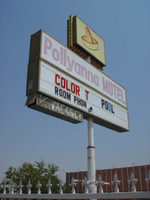
Photograph of Pollyanna Inn sign, Las Vegas (Nev.), 2002
Date
Archival Collection
Description
Site address: 4915 S Las Vegas Blvd
Sign details: North of the Klondike on the east side of Las Vegas Blvd., the Pollyana Inn sits separated on both sides by vacant lots. The establishment is no longer functioning, but is still present and standing. Inside an ornate, and locked, wrought iron gate, the Pollyana Inn sits dark, no cars present, and no patrons around. The closed facility sits separated from the street by a small parking lot. It too follows the true form of the roadside motel with its front office combined with a covered car port, then opening up into a square parking lot surrounded by lowrise stretches of adjacent rooms. The salmon and white alternating stripes of the buildings exterior surface is reminiscent of the color schemes popular in the establishment's heyday. In the cracked and broken pavement in the parking lot, small statuary of animals adorn the dying flowed beds, and shrubbery. Many of the plants still exist and flourish on the property. On the north side of the parking lot a statuette of a lion looks out onto the street and a fountain sits next to the building. In the center of the front of the lot, a triangular shaped, brick planter, home to bushes, a statuette of an elephant along with the pole sign for the property. The right of the lot is bordered off by a large non-functional, broken down internally lit message cabinet.
Sign condition: Structure 3 Surface 3 Lighting 3
Sign form: pylon
Sign-specific description: The pylon sign for the establishment's roadside pole sign is located in the triangular planter, facing north/south on the west edge of the property. A white steel pole supports an internally lit, double backed, white, plastic faced message cabinet. The cabinet is actually two narrow, horizontal, rectangular cabinets stacked on top of each other. The exterior steel casing is painted a dark olive hue. The top cabinet spells "Pollyanna Motel" in red plastic letters, with vinyl lettering on the message board below. Small steel cabinet is attached to the west side of the underbelly of the sign. "Vacancy is spelled in white text with neon spelling "No". The pole continues up through the top of the cabinet and is crowned with a small ,internally lit, brown cabinet. A yellow raceway with incandescent bulbs runs along the entire outer edge. The yellow plastic face has the image of a tilted sombrero on it.
Sign - type of display: Neon, incandescent, backlit
Sign - media: steel, plastic
Sign - non-neon treatments: graphics, paint
Sign animation: chasing, flashing
Surveyor: Joshua Cannaday
Survey - date completed: 2002
Sign keywords: Chasing; Flashing; Graphics; Paint; Steel; Plastic; Pylon; Neon; Incandescent; Backlit
Mixed Content
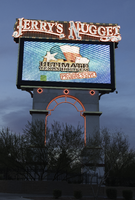
Photographs of Jerry's Nugget Casino sign, Las Vegas (Nev.), March 17, 2017
Date
Archival Collection
Description
Site address: 1821 N Las Vegas Blvd
Sign owner: The Stamis Family
Sign details: In 1964, Jerry Stamis and Jerry Lodge opened Jerry's Nugget Casino. The property, formerly the Towne House Bar, was converted into a casino. Four years after its opening, the owners bought the nearby Bonanza Club along with its sign, adding an additional 10,000 square feet to their property. The site has undergone numerous renovations, including in 1982 when it became a full-service casino complete with a restaurant, bars, and nearly 700 slots. The porte cochere was also added at that time. In 1996, a theatre lounge was added as well as a bakery and even more gaming tables. The casino, which celebrated its 50th anniversary in 2014. This location still claims to cater to "locals." Currently, it consists of slots, table games, keno lounge, and a bingo hall, among other popular features.
Sign condition: About 4-5, appears to have relatively low damage
Sign form: Sculptural pylon
Sign-specific description: Neon sign looks to be in the form of an oil derrick, "Jerry's" in a nugget shape at the top, "Nugget" spelled downward in light blue neon, possibly was once orange.
Sign - type of display: Neon
Sign - media: Steel
Sign environment: Located in North Las Vegas along Las Vegas Blvd, near the Silver Nugget Casino.
Sign - date of installation: 1964 for most of the signage for the property
Sign - date of redesign/move: 1982 Porte Cochere added with expansion
Sign - thematic influences: The signage conveys the Old West theme of striking it rich with gold, silver or oil, as they have an oil rig for portion of their sign.
Survey - research locations: Neon Museum tour outline, Jerry's Nugget website http://www.jerrysnugget.com/ , recorder's office, Assessor's page
Survey - research notes: For the 50th anniversary of their Company they donated the money for the restoration of their sign which is showcased on the documentary "Restoration Neon" and remains in the Neon Museum.
Surveyor: Carlyle Constantino
Survey - date completed: 2017-07-12
Sign keywords: Neon; Steel; Pylon; Incandescent; Back to back; Reader board; Video screen
Mixed Content
